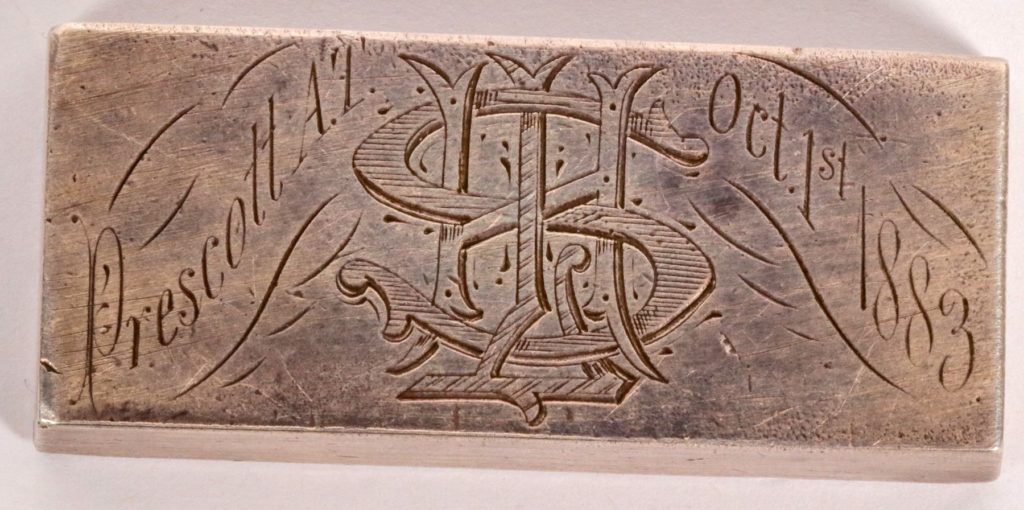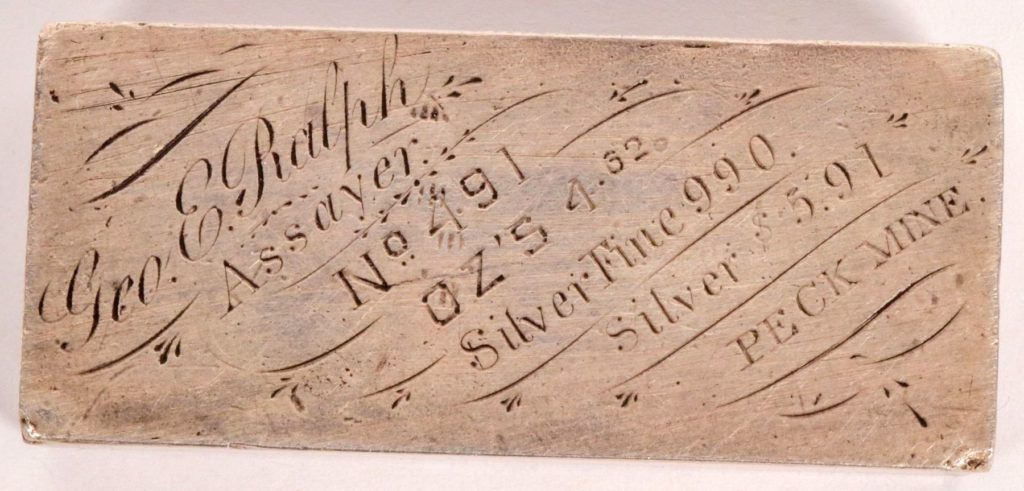4.62 oz Peck Mine Ingot, George E Ralph Assayer, Oct 1, 1883


The George Ralph Assayer, Peck Mine Silver Ingot, 1883
Fred n. Holabird, copyright 2023
Silver ingot, 2 1/8 x 15/16 x 7/16 thick. Trapezoidal.
- Top: Prescott A. T. / LHS (order uncertain)/ Oct. 1, 1883.
- Reverse: Geo. E. Ralph/ Assayer/ No. 491/ Ozs 4.52/ Silver Fine 990/ Silver $5.91/ Peck Mine
Classic Silver Assayer’s Ingot with silver from the Peck Mine in Prescott, Arizona from 1883.
Peck Mine History
The Peck mine was discovered by Ed Peck in 1875. He and a group of partners found very rich silver ore at the foot of a prominent outcrop which had never been prospected. Peck brought in a sack of the ore to be tested in nearby Prescott (about 20 miles away to the NNW). The ore was taken to Prescott assayer A.T. Rosenthal about June 30, 1875, and told his rocks were worth about $6,000 to $7,000 per ton. Peck and partners brought in about ten tons and sold the lot on the open market in Prescott at a great discount, raising needed cash to begin mining operations. Within a month, the mine was in full swing. L. B. Jewell was the first mine assayer hired. The group incorporated in Arizona, then in 1878 reincorporated in California in an attempt to raise more money through the very active San Francisco
stock market. Mining historian James Tenney called the Peck one of three “Bonanza” silver deposits found near Prescott in the early 1870s (History of Mining in Arizona, 1929). Within a month of discovery, the Peck had become a mining sensation. Colonel August V. Kautz, Commander of the Military
Department of Arizona, visited the Peck and nearby mines, writing a report dated July 14, 1875 in high praise for the mine. C. C. Bean of Prescott did the same on July 8. Both letters were published in part in Ross Raymond’s Mines and Mining West of the Rocky Mountains, 1877 (compiled in 1875), p347. Bean
reported “I lifted out myself chunks of pure grey sulfide of silver that would weigh from four to ten pounds, and that would yield at least 84 percent of silver.”
Soon a mining camp emerged at the mine, called Alexandra, named after Peck’s wife, who unfortunately died. (Henderson, Patrick C.; Peck Mine, in Arizona and the West, v4, #3, Autumn 1962). Alexandra supported the Tip Top, Black Warrior and other mines. The ores were so rich that they attracted the Janin brothers (louis, henry and Alex), whom had become important consulting mining engineers around the west, having gained exceptional experience on the Comstock and other major mines. The Janins were hired by the Peck MC and designed a mill for extraction of silver from Peck ore. The family archive today rests with the Huntington Library in San Marino, California, and has apparently not yet been utilized much by mining historians for its wealth in Arizona material. (Spude, Robert; Arizona Silver Mining, from Tubac to tombstone, 1999, p213 in v3,History of Mining in Arizona).
While much has been written by historians on the Peck, few have ventured into the facts concerning actual production. While that complete story is beyond the scope of this paper, a few notes are in order, particularly because casual historians have missed the mark about production. The mine produced
regularly from at least 1875 to 1885. Reporting after that period became difficult, as the reporting mechanisms changed radically, with the cessation of the Bureau of the Mint’s cessation of mine reports after 1885 as Congress handed off that duty to the new USGS. Esling and Heinman (Arizona Metal
Production, 1936, p102) report total production at $1 million, though the figures in this reference are all clearly rounded. This figure differs from others, and one is left to wonder about the actual production, which was probably significantly higher.
While the Peck was producing high grade silver, so too were developing “high grade” lawsuits over ownership in the mine. Burchard reported in 1882 for the year 1881 (p259): “the prosperity of the district has been severely retarded since 1878, by continuous litigation in respect to the legal ownership
of certain mines. This is especially the case in regard to the Peck, the most valuable mine yet developed. It was discovered in 1875 and worked with great success until 1878 when operations ceased owing to legal controversies. Its production during the three years was about $1.2 million.” Reports of production continued in annual volumes of Burchard through 1885.
The Peck Mine remained a staple of excitement regardless of the lawsuits. It was a popular place to visit, a half days stage ride from Prescott. Local assayers found themselves making silver ingots from peck bullion for visitors. News of some made the newspapers. In 1876, mine assayer Charles Pletz “just finished up six silver bricks … from the Peck Mine,” as reported in the Arizona Weekly Citizen in Tucson (July 8, 1876). Two Pletz ingots are known today, perhaps from this very group.
F. Blake was one of many assayers working in Prescott. His assay offices throughout California, Nevada and Idaho since the Gold Rush days have been well documented. In 1881, Blake hired a young assayer
who had been working for the Branch Mint at San Francisco, George Ralph.
The Murder of George Ralph, Prescott Assayer Ralph was a popular young man in Prescott, and a prominent member of Prescott Military Company.
Unfortunately for Mr. Ralph, he was murdered nine days after he made this ingot which bears the date October 1, 1883, shot and killed in cold blood by George W. Walker, a jealous local constable. Walker snuck into the back of Ralph’s assay furnace room at 7pm on October 10 and put five bullets in Ralph. While other workers were present, Walker snuck in without a sound and assassinated Ralph. After the shots had been heard, Walker had disappeared. He was found nearby by Indian trackers who followed
his trail and was also accused of robbing the Wickenburg stage the night before, though that news disappeared as soon as it was reported. There was quite a commotion in Prescott because of the killing. Walker was extremely jealous of Ralph’s “attention”; paid to Mrs. Walker, a very attractive young blond lady full of life who liked to socialize with men. (See “Terrible Tragedy”, Weekly Arizona Miner, Oct. 12, 1883.) In December, 1883 Walker was found guilty of manslaughter and sentenced to 9 years and 9 months in the State Prison at Yuma through a jury trial under Judge C.D.W. French. (Weekly Republican, Dec. 20, 1883.) In May 1885 he and a large group of friends petitioned the prison commissioners for a pardon and release. Roughly 10 days later, the pardon was soundly rejected. (Weekly Arizona Miner May 15, 1885 and Arizona Champion May 23, 1885.) There is another George Walker active in Tombstone around the same time period, although this is not the same man.
Following is a video of the ingot in hand and up close:
Summary
This historic silver ingot tells many stories about the West. It is from a “bonanza” silver mine, replete with ownership lawsuits, widely varying reports of production, attendant mining camps, stories of assayers, famous mining engineers, and murder. I can think of no other ingot so involved in every aspect of the “Wild West.”
[06/2023] https://www.icollector.com/Peck-Mine-Ingot-George-E-Ralph-Assayer-4-52oz-Oct-1-1883-168014_i49117383 ($38,560)
